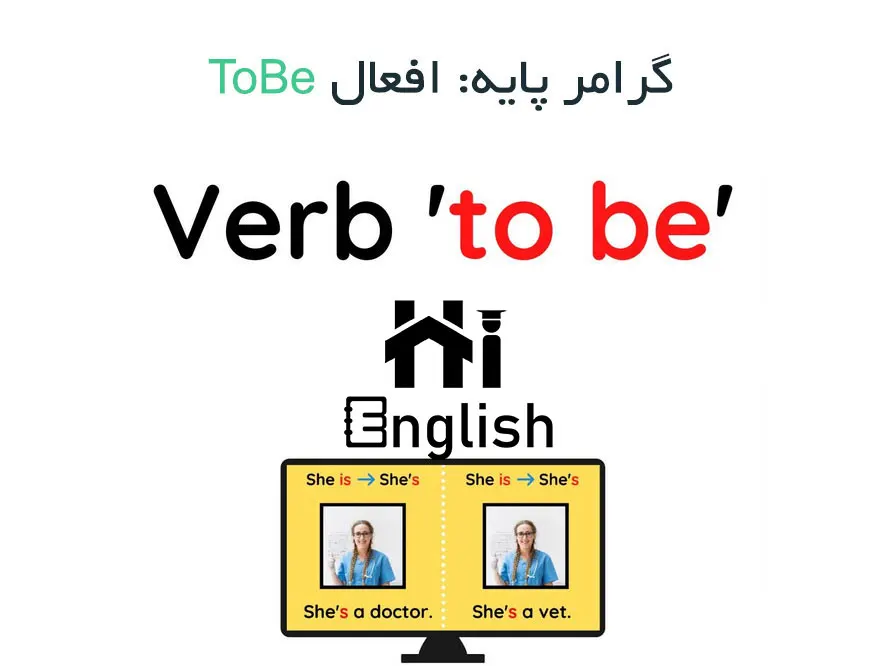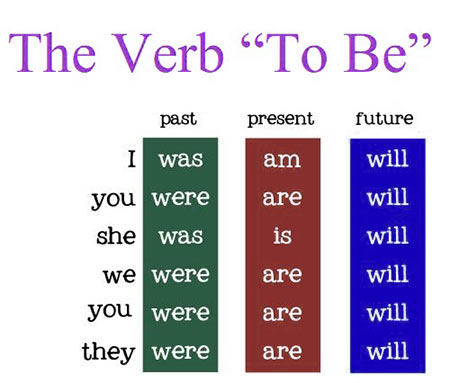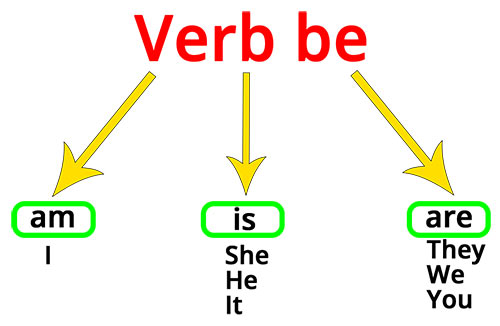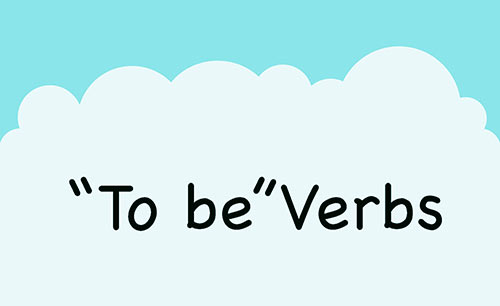گرامر پایه: افعال tobe

افعال “” tobe عبارتند از: are، am، is، was، were، been و بودن. از آنها برای توصیف یا بیان وضعیت افراد، اشیا، مکانها و ایدهها استفاده میشود. به عنوان مثال، آنها میتوانند سن، ملیت، شغل یا ویژگیهای دیگر سوژه را به ما بگویند tobe” عبارتند از: are، am، is، was، were، been و بودن. از آنها برای توصیف یا بیان وضعیت افراد، اشیا، مکانها و ایدهها استفاده میشود. به عنوان مثال، آنها میتوانند سن، ملیت، شغل یا ویژگیهای دیگر سوژه را به ما بگویند.
 این افعال از مهمترین افعال زبان انگلیسی هستند و در بسیاری از جملات استفاده میشوند. به عنوان مثال، این افعال برای تشریح وضعیت یک شخص، شی یا مکان استفاده میشوند.
این افعال از مهمترین افعال زبان انگلیسی هستند و در بسیاری از جملات استفاده میشوند. به عنوان مثال، این افعال برای تشریح وضعیت یک شخص، شی یا مکان استفاده میشوند.
استفادههای مهم افعال tobe
بعضی از استفادههای مهم این افعال در زبان انگلیسی شامل موارد زیر است:
بیان وضعیت شخص
-
- I am a student.
- She is happy.
- They are tired.
بیان وضعیت شی
-
- The book is on the table.
- The car is new.
- The house is old.
بیان وضعیت مکان
-
- The park is crowded.
- The restaurant is closed.
- The beach is beautiful.
بیان زمان
-
- I was at home yesterday.
- They were in the office last week.
- She has been to London several times.
بیان شرایط و موارد خاص
-
- It is raining outside.
- The cake was baked by my mother.
- The problem has been solved.
همچنین به دلیل مهم بودن افعال tobe در زبان انگلیسی، توصیه میشود که قواعد آنها را به خوبی یاد بگیرید و از تمرینات مربوط به آنها برای بهبود مهارت زبان انگلیسی خود استفاده کنید.
افعال tobe

در این درس خواهید آموخت که to be بهعنوان یک فعل پیونددهنده یا کمککننده استفاده میشود. از آنجایی که to be یک فعل بیقاعده است، بیایید قبل از غرق شدن در موارد، یک بررسی سریع از اشکال آن انجام دهیم.
| To Be: Present and Past Tenses | ||
|---|---|---|
| Person and Number | Present | Past |
| First person singular (I) | am | was |
| First person plural (we) | are | were |
| Second person singular or plural (you) | are | were |
| Third person singular (he, she, it) | is | was |
| Third person plural (they) | are | were |
| To Be: Present and Past Participles | |
|---|---|
| Present | Past |
| being | been
|
به عنوان یک فعل پیونددهنده
tobe به عنوان یک فعل پیونددهنده در نظر گرفته میشود که برای توصیف صفات، ویژگیها، احساسات و حالات وجودی استفاده بهکار میرود. اسم اصلی (یا فاعل) را به یک کلمه توصیف کننده مانند یک صفت یا اسم دیگر متصل میکند.
صفات و خصوصیات
- Daphne is very kind
Is links the noun Daphne and the adjective kind - My grandfather was a doctor
Was links the noun grandfather and the describing noun doctor
Emotions
- Lucy and Olivia are excited because their parents bought them a puppy for Christmas
Are links Lucy and Olivia to the adjective excited
اگر کلمهای که در ادامه قرار میگیرد به سؤالات کی یا کجا پاسخ دهد، بیانگر وضعیتی از وجود است.
- Wendell is here today
Is links Wendell to a state of being (here) - The party was at 7 o’clock
In this example, was links party to the time.
نکته: وقتی سوالی میپرسید، tobe در ابتدای جمله میآید و از کلمه توصیف کننده جدا میشود.
- ?Is Wendell here today
نکته: معمولاً کلمات و عباراتی که به سؤالاتی مانند کی و کجا پاسخ میدهند، قید در نظر گرفته میشوند، اما وقتی با افعال پیوند دهنده استفاده میشوند، مانند صفت عمل میکنند. این کلمات و عبارات اغلب به عنوان مکان یا مکمل قید نامیده میشوند.
به عنوان یک فعل کمک کننده بودن
قبلا یاد گرفتید که افعال کمکی با افعال اصلی برای کمک به تکمیل معنای فعل اصلی استفاده می شود. وقتی در زمانهای پیشرونده یا صدای مفعول استفاده میشود، to be یک فعل کمکی است.
بودن و زمانهای پیشرونده
فعل to be اغلب همراه با یک فعل حال (فعل که به -ing ختم میشود) برای بیان یک عمل در حال انجام استفاده میشود.
- Irena is listening to the teacher.
Is helps show that listening is an ongoing action happening in the present. - The squirrels were scampering across the lawn.
Were helps show that scampering was an ongoing action that occurred in the past. - My older brother has been writing a novel for the past five years.
Been helps to show that writing is an ongoing action. (Has is also a helping verb in this sentence, but it’s helping the verb to be.)
فعل tobe و افعال مجهول
افعال مجهول با فعل to be به اضافه مضارع تشکیل میشود. افراد زمانی که میخواهند به جای سوژه بر روی عمل تاکید کنند، یا زمانی که مطمئن نیستند که چه کسی آن عمل را انجام میدهد، از افعال مجهول استفاده میکنند.
- President Lincoln was assassinated by John Wilkes Booth
محور این جمله ترور رئیسجمهور است، نه شخصی که او را ترور کرده است.
- My wallet and phone were stolen at the beach
ما نمیدانیم چه کسی کیف و گوشی را دزدیده است و میخواهیم به جای فردی که این سرقت را انجام داده است، بر عمل سرقت تاکید کنیم.
افعال مشارکتی در مقابل صفتهای مشارکتی
از قبل میدانید که to be اغلب به عنوان یک فعل کمکی قبل از فعل حال یا ماضی عمل میکند. با این حال، برخی از اجزاء را میتوان به عنوان صفت (در توصیف کلمات) نیز استفاده کرد. هنگامی که to be با این صفتها استفاده میشود، یک فعل پیوند دهنده است، نه یک فعل کمک کننده. اگر مطمئن نیستید که to be یک فعل پیوند دهنده یا کمک کننده در یک جمله خاص است، فقط به این فکر کنید که آیا جزء یک توصیف است یا یک عمل. بیایید به چند مثال نگاهی بیندازیم، که با صفتهای فعلی در مقابل زمانهای فعلی در زمانهای پیش رونده شروع میکنیم.
| Present Participial Adjectives vs. Progressive Tenses | |
|---|---|
| Linking (Adjective ending in -ing) |
Helping (Main action verb ending in -ing) |
(Soothing describes the teacher’s voice.) |
(Listening is an action, not a description.) |
(Fascinating describes the novel.) |
(Writing is an action, not a description.) |
حال بیایید تفاوت بین صفتهای ماضی و مضارع در افعال مجهول را بررسی کنیم.
| Past Participial Adjectives vs. Passive Voice | |
|---|---|
| Linking (Adjective ending in -ed, -en, -t, etc.) |
Helping (Action verb ending in -ed, -en, -t, etc.) |
(Excited describes how the girls feel.) |
(Destroyed is an action. It tells us what the puppy did.) |
(Interested describes my state of mind.) |
(Startled is an action. It tells us what the loud noise did to me.) |

پنج نکته گرامری درباره افعال tobe
البته، برای استفاده صحیح از افعال tobe، لازم است که برخی نکات گرامری را در نظر بگیرید. شش نکته مهم در این زمینه عبارتند از:
- شکل سوم افعال tobe به صورت been است و برای ساختن افعال گذشته استفاده میشود. به عنوان مثال:
- I have been to Paris. (من به پاریس رفتهام)
- They have been studying English for three years. (آنها سه سال است که انگلیسی میخوانند)
- فعل tobe در زمان حال ساده با ضمیر I به شکل am و با ضمایر he, she, it به شکل is و با ضمایر we, you, they به شکل are میآید. به عنوان مثال:
- I am a teacher. (من یک معلم هستم)
- She is my friend. (او دوست من است)
- We are busy. (ما مشغول هستیم)
- افعال tobe میتوانند در جملات مثبت، منفی و سوالی به کار روند. به عنوان مثال:
- Positive: He is a doctor. (او یک دکتر است)
- Negative: She is not happy. (او خوشحال نیست)
- Question: Are you a student? (آیا شما دانشجو هستید؟)
- برای تشخیص مجهول بودن یک جمله، از افعال tobe به شکل was و were با حرف شناخته شده انگلیسی “by” به عنوان حرف اضافه بعد از فاعل جمله استفاده میشود. به عنوان مثال:
- The book was written by Mark Twain. (این کتاب توسط مارک تواین نوشته شده است)
- The building was designed by an architect. (این ساختمان توسط یک معمار طراحی شده است)
- برای نشان دادن تغییر وضعیت از حالت یک شرایط به حالت دیگر، از افعال tobe به شکل am, is و are در کنار شکل ing فعل استفاده میشود. این ساختار به صورت حال استمراری شناخته میشود. به عنوان مثال:
- I am studying English. (من در حال یادگیری زبان انگلیسی هستم)
نمونه سوالات افعال tobe
 1 – Which of the following is a correct form of the present continuous tense of “to be”?
1 – Which of the following is a correct form of the present continuous tense of “to be”?
a) am b) is c) are d) all of the above
Answer: d) all of the above
2 – Which of the following is a correct form of the past tense of “to be”?
a) was b) were c) did d) do
Answer: a) was
3 – Which of the following is a correct form of the future tense of “to be”?
a) will be b) would be c) may be d) might be
Answer: a) will be
4 – Which of the following is an example of the present perfect tense of “to be”?
a) I am working. b) I have been working. c) I had been working. d) I will be working.
Answer: b) I have been working.
5 – Which of the following is an example of the past continuous tense of “to be”?
a) I am talking. b) I was talking. c) I will be talking. d) I had been talking.
Answer: b) I was talking.
6 – Which of the following is an example of the future continuous tense of “to be”?
a) I am going to work. b) I will be working. c) I have been working. d) I had been working.
Answer: b) I will be working.
7 – Which of the following is an example of the present perfect continuous tense of “to be”?
a) I am working. b) I have been working. c) I had been working. d) I will be working.
- Answer: b) I have been working.
8 – Which of the following is an example of the past perfect tense of “to be”?
a) I am working. b) I have been working. c) I had been working. d) I will be working.
Answer: c) I had been working.
9 – Which of the following is an example of the future perfect tense of “to be”?
a) I am going to work. b) I will be working. c) I will have been working. d) I had been working.
Answer: c) I will have been working.
10 – Which of the following is an example of the present subjunctive mood of “to be”?
a) If I am at home, I will answer the phone. b) If I were at home, I would answer the phone. c) If I had been at home, I would have answered the phone. d) If I will be at home, I will answer the phone.
Answer: b) If I were at home, I would answer the phone.
